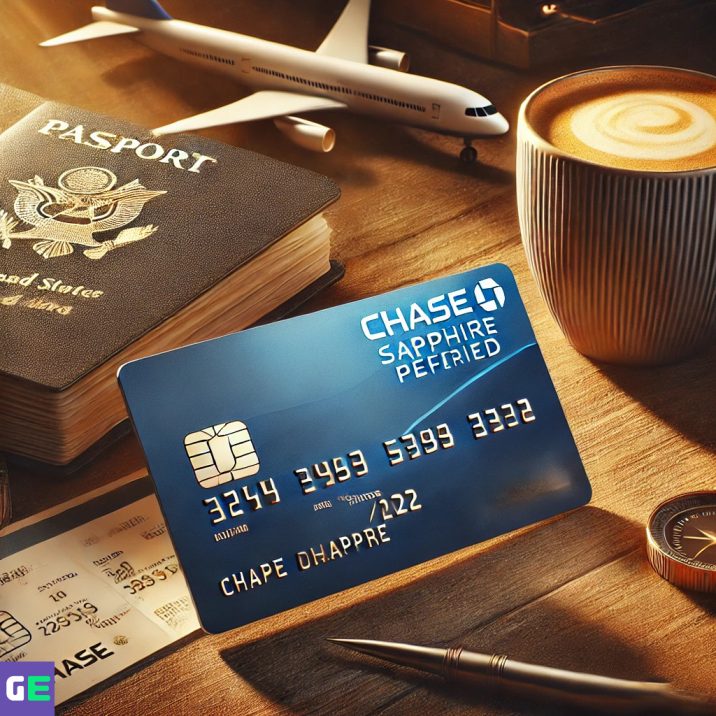Introduction
The Chase Sapphire Preferred card has been a top travel credit card for years, known for its generous rewards, flexible redemption options, and travel-friendly perks. As 2025 unfolds, many potential cardholders are wondering: Is the Chase Sapphire Preferred still worth it?
In this in-depth review, we will analyze every aspect of the Chase Sapphire Preferred, including its benefits, fees, rewards program, and how it compares to other credit cards. Whether you’re a frequent traveler, a dining enthusiast, or someone looking to maximize credit card rewards, this review will help you determine if the Chase Sapphire Preferred is the right fit for your wallet.
Overview of Chase Sapphire Preferred
The Chase Sapphire Preferred is a mid-tier travel credit card that offers excellent value for both frequent and occasional travelers. It strikes a balance between affordability and premium benefits, making it one of the most popular credit cards in the United States.
Basic Details of Chase Sapphire Preferred
-
Annual Fee: $95
-
Sign-Up Bonus: Typically around 60,000 – 75,000 points (varies throughout the year)
-
Rewards Structure: Earn points on travel, dining, and other categories
-
Redemption Value: Points can be used for travel, statement credits, or transferred to travel partners
-
Foreign Transaction Fees: None, making it great for international travel
With these features, the Chase Sapphire Preferred remains a strong option for those looking to earn rewards on everyday spending while enjoying premium travel perks.
Key Features & Benefits of Chase Sapphire Preferred
1. Generous Sign-Up Bonus
One of the biggest selling points of the Chase Sapphire Preferred is its welcome bonus, which often ranges from 60,000 to 75,000 Chase Ultimate Rewards® points after meeting the minimum spending requirement (usually $4,000 in the first 3 months).
This bonus alone can be worth over $750 in travel when redeemed through Chase Travel℠, or even more when transferred to airline and hotel partners.
2. Strong Rewards on Travel & Dining
The Chase Sapphire Preferred offers a rewarding points structure:
-
5X points on travel booked through Chase Travel℠
-
3X points on dining (including takeout and delivery)
-
3X points on streaming services and select online grocery purchases
-
2X points on all other travel purchases
-
1X points on everything else
For those who spend frequently on dining and travel, this card provides excellent long-term value.
3. Flexible Redemption Options
Unlike many credit cards with restrictive redemption options, the Chase Sapphire Preferred allows cardholders to maximize their points in several ways:
-
Chase Travel Portal: Points are worth 25% more when redeemed for flights, hotels, and rental cars.
-
Transfer to Travel Partners: Points can be transferred at a 1:1 ratio to leading airline and hotel programs like United, Southwest, Hyatt, and Marriott.
-
Cash Back or Statement Credits: Points can also be redeemed for cash back, though this is not the best use of points.
4. Travel Perks & Protections
Unlike some basic credit cards, the Chase Sapphire Preferred includes several valuable travel benefits:
-
No Foreign Transaction Fees – Save money on international purchases.
-
Trip Cancellation/Interruption Insurance – Get reimbursed up to $10,000 per person for non-refundable travel expenses.
-
Primary Rental Car Insurance – Covers collision damage on car rentals, a rare perk for a card at this price point.
-
Baggage Delay & Travel Delay Coverage – Reimbursement for expenses due to delayed luggage or travel.
5. Purchase Protection & Extended Warranty
Beyond travel benefits, the Chase Sapphire Preferred also provides:
-
Purchase Protection – Covers new purchases against damage or theft for up to 120 days.
-
Extended Warranty – Adds an extra year of warranty coverage on eligible purchases.
These features make the Chase Sapphire Preferred a well-rounded rewards card that provides both travel and everyday purchase benefits.
Fees & Interest Rates
While the Chase Sapphire Preferred is packed with benefits, it’s important to consider its fees and interest rates:
-
Annual Fee: $95
-
APR: Variable, typically ranging from 21.24% to 28.24% (varies based on creditworthiness)
-
Balance Transfer Fee: 5% of the transfer amount
-
Cash Advance Fee: Either $10 or 5% of the amount (whichever is greater)
The Chase Sapphire Preferred is best suited for those who pay off their balance in full each month to avoid interest charges.
Pros & Cons of Chase Sapphire Preferred
✅ Pros:
✔️ High sign-up bonus compared to other travel credit cards.
✔️ Bonus points on travel and dining make it great for frequent spenders.
✔️ Ultimate Rewards points are valuable & transferable.
✔️ Excellent travel insurance & purchase protections.
✔️ No foreign transaction fees for international purchases.
❌ Cons:
❌ $95 annual fee, though it’s offset by rewards for most users.
❌ No airport lounge access, unlike premium travel cards.
❌ Limited bonus categories compared to some competitor cards.
Chase Sapphire Preferred vs. Other Travel Cards
1. Chase Sapphire Preferred vs. Chase Sapphire Reserve
-
Chase Sapphire Preferred: Lower annual fee ($95) and strong rewards.
-
Chase Sapphire Reserve: Higher annual fee ($550) but includes Priority Pass lounge access and higher travel credits.
-
Verdict: Get the Chase Sapphire Preferred if you want solid travel rewards at a lower cost.
2. Chase Sapphire Preferred vs. Capital One Venture
-
Capital One Venture: 2X miles on every purchase, no transfer partners like Chase.
-
Verdict: If you prefer simple flat-rate rewards, the Venture card is better. If you value travel transfer partners, choose Chase Sapphire Preferred.
3. Chase Sapphire Preferred vs. Amex Gold
-
Amex Gold: 4X on dining & groceries, but higher annual fee ($250).
-
Verdict: Amex Gold is better for foodies, but Chase Sapphire Preferred is more versatile for travel rewards.
Who Should Get the Chase Sapphire Preferred?
The Chase Sapphire Preferred is ideal for:
-
Frequent travelers who want valuable points & travel insurance.
-
Dining lovers who eat out often.
-
People who want a travel card with a low annual fee.
-
Beginners looking for a great first travel rewards card.
However, if you need premium perks like airport lounge access or high-end travel credits, you might consider Chase Sapphire Reserve instead.
How to Apply & Increase Your Approval Odds
To get approved for the Chase Sapphire Preferred, you generally need:
-
A good to excellent credit score (700+).
-
A low credit utilization ratio.
-
Not holding another Sapphire card (Chase’s “one Sapphire rule”).
Pro Tip: If you’re on the fence, check for pre-approval on Chase’s website before applying.
Final Verdict: Is Chase Sapphire Preferred Still Worth It in 2025?
The Chase Sapphire Preferred remains one of the best travel credit cards in 2025. With strong rewards, flexible redemptions, and great travel protections, it easily justifies its $95 annual fee.
✅ If you travel frequently and want a powerful yet affordable rewards card, Chase Sapphire Preferred is still one of the best choices this year Read more
FAQs
1. What is the current sign-up bonus for Chase Sapphire Preferred in 2025?
The Chase Sapphire Preferred frequently offers an impressive sign-up bonus, making it one of the most sought-after travel credit cards. As of 2025, the standard welcome bonus is 60,000 to 75,000 Chase Ultimate Rewards points after spending $4,000 in the first 3 months.
This bonus alone is worth at least $750 when redeemed through Chase Travel℠ or potentially more when transferred to travel partners like United, Hyatt, and Southwest Airlines. This makes the Chase Sapphire Preferred an excellent choice for those who want to maximize travel rewards with a low annual fee of just $95.
2. How does Chase Sapphire Preferred earn rewards on purchases?
The Chase Sapphire in Preferred has a tiered rewards system, allowing cardholders to earn points on different spending categories:
-
5X points on travel booked through Chase Travel℠
-
3X points on dining, including restaurants, takeout, and eligible delivery services
-
3X points on streaming services and select online grocery purchases
-
2X points on all other travel purchases outside of Chase Travel℠
-
1X points on everything else
This flexible rewards system makes the Chase Sapphire in Preferred an excellent card for both frequent travelers and everyday spenders looking to earn points quickly.
3. How can I redeem Chase Sapphire Preferred points for maximum value?
The Chase Sapphire in Preferred allows you to redeem points in multiple ways, but to get the best value, consider these options:
-
Chase Travel Portal (25% More Value) – When you book travel through Chase Travel℠, your points are worth 25% more. For example, 60,000 points = $750 in travel credit.
-
Transfer to Airline & Hotel Partners – Convert your points at a 1:1 ratio to top travel programs like Hyatt, United Airlines, Southwest Airlines, and Marriott Bonvoy. This can often increase the value of your points beyond 1.25 cents per point.
-
Cash Back & Statement Credits – If you prefer flexibility, you can redeem points for cash back or statement credits (typically at 1 cent per point, which is lower than travel redemptions).
For most users, transferring points to airline and hotel partners will provide the highest value for their rewards.
4. What credit score is needed to get approved for Chase Sapphire Preferred?
To get approved for the Chase Sapphire in Preferred, you generally need a good to excellent credit score. A FICO score of 700 or higher is recommended, but approvals are based on multiple factors such as income, credit history, and existing Chase relationships.
If you’re unsure whether you’ll qualify, you can check for pre-approval on the Chase website without affecting your credit score. Keep in mind that Chase has the 5/24 rule, meaning if you’ve opened 5 or more credit cards in the past 24 months, your application may be denied.
5. Does Chase Sapphire Preferred have foreign transaction fees?
No, the Chase Sapphire in Preferred does not charge foreign transaction fees, making it an excellent travel credit card for international trips. Whether you’re dining in Paris, booking a hotel in Tokyo, or shopping in Mexico, you can use the card without worrying about extra charges.
Many other credit cards charge a 3% foreign transaction fee, so using the Chase Sapphire Preferred can save you money while traveling abroad.
6. Can I upgrade from Chase Sapphire Preferred to Chase Sapphire Reserve?
Yes, if you currently have the Chase Sapphire in Preferred, you may be eligible to upgrade to the Chase Sapphire Reserve, which is Chase’s premium travel card. However, there are a few things to consider:
-
You must have held the Chase Sapphire Preferred for at least one year before requesting an upgrade.
-
Upgrading means you won’t qualify for a new sign-up bonus. If you want the Reserve’s bonus, it’s better to apply separately.
-
The Chase Sapphire Reserve has a higher annual fee of $550 but comes with premium perks like airport lounge access, $300 travel credit, and 10X points on hotels & car rentals.
If you travel often and want more premium benefits, upgrading from the Chase Sapphire in Preferred to the Chase Sapphire Reserve might be worth it.
7. Can I have both Chase Sapphire Preferred and Chase Sapphire Reserve?
No, Chase does not allow cardholders to hold both the Chase Sapphire Preferred and Chase Sapphire Reserve at the same time. Chase enforces a “One Sapphire Rule”, meaning you must choose between the two.
If you currently have the Chase Sapphire in Preferred and want to switch to the Reserve, you’ll need to upgrade or cancel your existing card before applying for the other.
8. How does Chase Sapphire Preferred compare to Amex Gold?
The Chase Sapphire in Preferred and the American Express® Gold Card are both excellent for earning travel rewards, but they cater to different spending habits:
-
Chase Sapphire in Preferred: Best for travel and flexible point transfers, lower annual fee ($95), primary rental car insurance, and 25% travel bonus when redeeming points through Chase.
-
Amex Gold: Best for foodies, earns 4X points on dining & U.S. supermarkets, but has a higher annual fee of $250.
If you travel frequently, the Chase Sapphire Preferred is the better choice. If you spend more on food & groceries, the Amex Gold might be more rewarding.
9. Is Chase Sapphire Preferred still worth it if I don’t travel often?
Yes! While the Chase Sapphire Preferred is marketed as a travel credit card, it still provides excellent value for non-travelers. Here’s why:
-
3X points on dining & streaming services
-
2X points on everyday transportation like gas, rideshares, and commuting
-
Strong purchase protection and extended warranty benefits
-
Option to redeem points for statement credits or cash back
Even if you don’t travel much, the Chase Sapphire in Preferred is a great way to earn rewards on everyday purchases while still having the option to use points for travel in the future.
10. How can I increase my Chase Sapphire Preferred approval chances?
To boost your chances of getting approved for the Chase Sapphire Preferred, follow these tips:
-
Ensure your credit score is above 700 before applying.
-
Lower your credit utilization ratio (keep balances below 30% of your credit limit).
-
Avoid opening too many credit cards in a short period (Chase’s 5/24 rule).
-
Have a stable income and a positive credit history.
If you don’t get approved immediately, you can call Chase’s reconsideration line to discuss your application. Many applicants get approved after providing additional information.
Final Thoughts
The Chase Sapphire Preferred continues to be one of the best travel credit cards in 2025, offering valuable rewards, travel perks, and purchase protections. Whether you’re a frequent traveler or someone looking to earn rewards on everyday spending, the Chase Sapphire Preferred remains a top choice for U.S. consumers













Leave a Reply